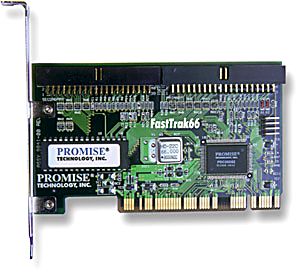[ The PC Guide | Systems and Components Reference Guide | Hard Disk Drives | Hard Disk Performance, Quality and Reliability | Redundant Arrays of Inexpensive Disks (RAID) | RAID Configuration and Implementation | RAID Controllers and Controller Features ]
Hardware RAID
Most "serious" RAID implementations use what is termed hardware RAID. This means using dedicated hardware to control the array, as opposed to doing array control processing via software. Good hardware controllers are in many ways like miniature computers, incorporating dedicated processors that exceed the power of processors that ran entire PCs just a few years ago. For a list contrasting software and hardware RAID, showing the advantages and disadvantages of each, see this page on software RAID.
There are two main types of hardware RAID, differing primarily in how they interface the array to the system:
- Bus-Based or Controller Card Hardware RAID: This is the more conventional type of hardware RAID, and the type most commonly used, particularly for lower-end systems. A specialized RAID controller is installed into the PC or server, and the array drives are connected to it. It essentially takes the place of the SCSI host adapter or IDE/ATA controller that would normally be used for interfacing between the system and the hard disks; it interfaces to the drives using SCSI or IDE/ATA, and sends data to the rest of the PC over the system bus (typically PCI). Some motherboards, particularly those intended for server systems, come with some variant of integrated RAID controller. These are built into the motherboard, but function in precisely the same manner as an add-in bus-based card. (This is analogous to the way that the integrated IDE/ATA controllers on all modern motherboards function the same way that add-in IDE/ATA controllers once did on older systems.) The only difference is that integrated controllers can reduce overall cost--at the price of flexibility.
- Intelligent, External RAID Controller: In this higher-end design, the RAID controller is removed completely from the system to a separate box. Within the box the RAID controller manages the drives in the array, typically using SCSI, and then presents the logical drives of the array over a standard interface (again, typically a variant of SCSI) to the server using the array. The server sees the array or arrays as just one or more very fast hard disks; the RAID is completely hidden from the machine. In essence, one of these units really is an entire computer unto itself, with a dedicated processor that manages the RAID array and acts as a conduit between the server and the array.
|
A PCI-bus-based, IDE/ATA hard disk RAID |
Original image � Promise Technology Inc. |
Bus-based RAID is cheaper and much simpler to implement than external RAID controllers while still offering often impressive capabilities; they range from entry-level cards for IDE/ATA systems that cost around $100, up to top-of-the-line, full-featured devices costing several thousand dollars. Dedicated, external RAID controller systems are still more expensive but offer many advanced features, are typically more expandable than bus-based RAID implementations (offering support for large array well into the terabytes) and can offer better performance. They often cost well into the five figures, so they are not something a typical PC user would even consider.
![]() Note: External RAID
controllers should not be confused with external RAID enclosures. Enclosures provide power and physical infrastructure for
the drives in a RAID array, but not the smarts of the controller; they are functionally a
large, fancy PC system case. An external RAID controller can be thought of as such an
enclosure combined with a high-end, integrated controller as well.
Note: External RAID
controllers should not be confused with external RAID enclosures. Enclosures provide power and physical infrastructure for
the drives in a RAID array, but not the smarts of the controller; they are functionally a
large, fancy PC system case. An external RAID controller can be thought of as such an
enclosure combined with a high-end, integrated controller as well.
In most cases, the decision to use hardware RAID is made almost exclusively on financial grounds: hardware RAID is superior to software RAID in virtually every way, it just costs more. If you want to use any of the more esoteric RAID levels such as RAID 3 or RAID 1+0, you pretty much require hardware RAID, since support for these levels is usually not offered in software. If you need top performance while using a computation-intensive RAID level such as RAID 5, you also should consider a hardware solution pretty much "mandatory", because software RAID 5 can really hurt performance.
![]() Next: Software RAID
Next: Software RAID
| The PC Guide
(http://www.PCGuide.com) Site Version: 2.2.0 - Version Date: April 17, 2001 © Copyright 1997-2004 Charles M. Kozierok. All Rights Reserved. |
Not responsible for any loss resulting from the use of this site. Please read the Site Guide before using this material. |
